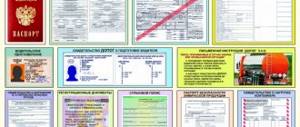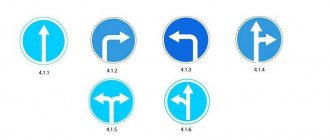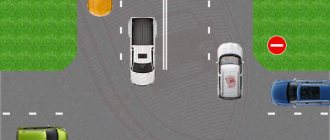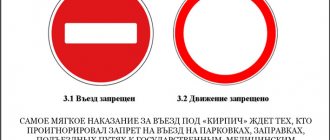Good day, dear car enthusiasts. I think it’s no secret to anyone that the budget of our country in general and a specific region in particular is formed, among other things, by drivers who commit traffic violations, which ultimately leads to an administrative violation report being issued. Then, of course, it’s everyone’s personal choice to pay or not to pay, but for the most part, motorists are respectable people and pay the fine. Replenishing the budget is, of course, a good and necessary thing, but I wanted it not to come from our pockets. In no way am I advocating ignoring the payment of fines. We'll go the other way.
Not all traffic violations are committed by the driver consciously. Very often the opposite situation occurs: the driver had no idea that he had violated one or another point of the rules.
Today I will talk about what through traffic is and how not to get a fine for it.
Basic provisions
Through traffic is the movement of a vehicle across a territory, provided that entry and exit to it is carried out from different sides, and the reasons for visiting this area do not include loading/unloading goods or boarding/disembarking passengers.
In order for a movement to fall under the definition of through, two conditions must be met:
- Availability of entry and exit at different points.
- There is no end point of the route or the required object in the territory for through traffic.
The traffic rules prohibit through traffic in residential areas. But motorists violate it by making a short stop and continuing along the original route.
Is it possible to drive through parking lots, gas stations, and shopping center areas?
The traffic rules do not stipulate a ban on avoiding obstacles through parking lots, gas stations and shopping center areas. That is, law enforcement agencies cannot fine you for driving without stopping through the roadways of these objects. But these plots are private, so other rules invented by the owner may apply here. Some shopping centers, for example, have come up with a rule for paid stay on their territory for less than 15 minutes.
Of course, an inventive driver can always bypass any traffic rules, but do not forget that they were all invented for a reason. And if in a residential area a child suddenly jumps out under the wheels of your car to grab his ball, responsibility for the incident will fall entirely on you.
Source
Traffic rules in residential areas
A residential area is understood as a territory, all entrances to and exits from which are indicated by the following road signs, but in fact this is an area where residential buildings, schools, clinics and everything related to human habitation are located.
In the residential area, pensioners and mothers with small children stroll imposingly, hence a number of restrictions follow.
Namely, it is prohibited:
It is also important that the above restrictions also apply to courtyard areas.
What is through traffic?
For movement to be considered end-to-end, two conditions must be met:
- entry and exit must be carried out through different access points;
- the driver had no intermediate destinations. For example, boarding or disembarking passengers, loading or unloading cargo, going to the store, or whatever.
The fine for through passage, according to Part 1 of Article 12.28 of the Code of Administrative Offences, is 1,500 rubles.
In other words, for prohibited through passage through a yard or residential area you will have to pay to the state, in my opinion a considerable 1,500 rubles. And here you can find out which fines can be paid at a discount.
Where is the prohibition sign installed?
There are two terms in the Traffic Rules - residential area and yard area. Section 17.4 of this document contains special requirements for the movement of vehicles in these zones. And it is at their borders that a sign prohibiting through passage is installed.
The residential zone includes the area of the settlement with residential buildings located on it, infrastructure and cultural organizations, and other objects necessary for the full-fledged residence of people. Courtyards and large towns or neighborhoods also belong to residential areas.
To determine the boundaries of a residential area, the following is used:
- sign 5.21 indicating entry;
- sign 5.22 indicating exit.
The residential zone may include not only the houses themselves, but also places where people gather, where it is necessary to limit the intensity of vehicle traffic. Thus, the listed signs can be installed in the parking lots of shopping or business centers, and certain sections of streets.
The term yard territory includes a much smaller area:
- the residential building itself;
- playground;
- flower beds and lawns around;
- rest areas at entrances;
- access routes to the house itself and infrastructure facilities.
Traffic speed in residential area
The maximum speed in residential areas and courtyards is 20 km/h. (Clause 10.2 of the Traffic Regulations)
Car - bicycle: priority in the yard
As already discussed above, in a yard or residential area, section 17 of the traffic rules gives priority to pedestrians. In fact, this advantage is formal, but legally it is on the side of the pedestrian.
In accordance with paragraph 1.2 of the traffic rules, a bicycle is a vehicle, i.e. A cyclist is not a pedestrian. A cyclist will become a pedestrian only when he “dismounts” and will not ride, but roll the bicycle, i.e. walk next to him.
And since a bicycle is a vehicle, the movement of cyclists in the yard and residential area is subject to the general Rules, and in front of a car in the yard, a cyclist does NOT have the same priority as pedestrians. Read more in the article Car - bicycle: who has priority in the yard.
Traffic rules for cyclists are set out in Section 24 of the Traffic Regulations: Additional requirements for the movement of cyclists and moped drivers.
Oncoming traffic in the yard
Since these Rules apply in courtyards and residential areas, oncoming traffic must be carried out in accordance with clause 11.7. In general cases, the vehicle on whose side there is an obstacle must give way. Anything can be an “obstacle” in the yard that makes it difficult to pass on your side of the road, including someone’s car parked at its edge.
But in this case, just like at street intersections, there are unspoken rules of driver solidarity and a rational approach to resolving a controversial situation.
Driving through intersections in yards
The order of travel on intersecting roads is determined by the presence of priority signs before the intersection. If there are no priority signs, then the roads being crossed are considered to be of equal importance, and at such yard “intersections” the “interference on the right” rule applies. The vehicle approaching from the right has the right of way.
In residential areas, with their extensive network of local roads, there are roads with fairly wide carriageways. When there are no priority signs, the width of a wide road does NOT make it a priority over a narrow crossing or adjoining road.
The reality is that many drivers, for various reasons, ignore this rule, mistakenly believing that road width matters.
The safety of passage of such sections is determined not by formal priority, but by the guarantee of the absence of accidents. Who can guarantee this? - only you. By having the right of way and giving way, you are NOT breaking the Rules.
Stopping and parking in the yard
Stopping and parking in courtyards or residential areas usually does not raise any questions, except in cases where there is not enough parking space (there are many cars, but few spaces). But now we are not talking about private disputes and claims for parking spaces, but the question of compliance with traffic regulations for parking in the yard. The car can be parked at the edge of the road without blocking the passage (entry/exit).
In courtyards and residential areas, parking with the engine running is prohibited, and it is also prohibited to park trucks with a permissible maximum weight of more than 3.5 tons outside specially designated areas marked with signs or markings. Parking for such vehicles is indicated by sign 6.4 “Parking (parking space)”.
What does the term through traffic mean, and how to carry out through traffic without a fine?
Good day, dear car enthusiasts. I think it’s no secret to anyone that the budget of our country in general and a specific region in particular is formed, among other things, by drivers who commit traffic violations, which ultimately leads to an administrative violation report being issued. Then, of course, it’s everyone’s personal choice to pay or not to pay, but for the most part, motorists are respectable people and pay the fine. Replenishing the budget is, of course, a good and necessary thing, but I wanted it not to come from our pockets. In no way am I advocating ignoring the payment of fines. We'll go the other way.
Not all traffic violations are committed by the driver consciously. Very often the opposite situation occurs: the driver had no idea that he had violated one or another point of the rules.
Today I will talk about what through traffic is and how not to get a fine for it.
Assignment of the fine
The fine for driving through a residential area is established by the legal provisions of the law and amounts to 1,500 rubles. It must be paid without fail, since traffic police officers record a violation of traffic rules.
In order to avoid a fine, it is necessary to make a forced stop during travel or disembark passengers. In other cases, the driver’s actions are considered illegal, and he will be brought to administrative responsibility.
This preventive measure is justified, since in a residential area children play on the sidewalks, elderly people move slowly, so this decision was made to ensure the safety of pedestrians.
What to do if they refuse again
Another refusal can be appealed in court. For such cases there is a special Code of Administrative Proceedings of the Russian Federation. One of his tasks is to monitor the work of officials. If a person believes that officials are not working, he can go to court. The CAS court will consider whether the officials really should have taken action and will order them to do so if it turns out that this is the case.
You can appeal against the inaction of officials within three months from the moment you receive the next refusal.
In this case, the court will not be able to hold a specific official accountable. But it may recognize his inaction as illegal and oblige him, for example, to install a road sign or restrict passage in another way.
But in general, installing road signs by court order is an ordinary practice. Let me give you an example: the prosecutor’s office revealed that in the city, at one of the pedestrian crossings, the “Pedestrian Crossing” road sign was not duplicated. And she went to court to oblige the city hall’s urban services department to eliminate the violation. Representatives of the mayor's office did not object that the sign was needed, but asked to postpone the installation date to next year - because this year there is no money in the budget for such work.
Possibility of closing the crossing in the yard
Many people are interested in the question of how to legally and without claims from management authorities block a through passage and protect a residential area from the roadway.
Experts on such issues recommend trying some of the recommendations listed below.
- Installation of identification posts. This method is not suitable for all residential courtyards, since such fences may violate fire safety standards. In emergency situations, residential areas must have such entrances for unhindered entry of emergency vehicles.
- Installation of a barrier. A procedure of this kind is most often acceptable in small yards and the presence of entrances that do not violate safety standards. As an additional service, you can install a booth with a security guard to monitor compliance with the assigned rules, but this method will be very expensive for residents of the houses.
- Use of signs. The current legislation does not provide for the independent installation of signs prohibiting entry, so the issue should be discussed with traffic police officers. The procedure is carried out by state traffic inspectorates.
- Introduction of the speed bump system. This technique is not particularly effective, since this still prevents cars from crossing the territory of a residential area. At the same time, the installation itself is not prohibited by law and can be carried out by interested parties on their own terms.
- Submitting an application to the State Traffic Inspectorate of the Ministry of Internal Affairs. The document is drawn up in the form of a complaint and sent to the official representative office by regular mail or email, filling out the paper on the website of the government agency.
- Contact the district administration authorities. If the submitted complaint is ignored, then it is necessary to redirect it to the executive authorities. The document describes in detail the existing information and provides evidence of the need to install the appropriate identification mark.
If the submitted application was ignored by all higher institutions, then the applicant has every right to file a complaint with law enforcement agencies or the Ministry of Transport. The document can be delivered in person or sent by registered mail.
The document must indicate the lack of response from self-government bodies and traffic police.
Attention! The complaint must be considered without fail, since these authorities are the highest authorities in the state on this issue.
Another option for solving the problem is to file a lawsuit to open appropriate records. The court does not have the right to refuse to consider the application, therefore, a final verdict will be made based on the complaint and further resolution of the situation.
Is it allowed to drive through parking lots, gas stations, and shopping center areas?
There is no clear answer in the traffic rules, so there are two radically different answers to this question:
- clause 1.1 states the uniformity of the established rules throughout Russia. And according to them, the adjacent territory includes gas stations, courtyards and parking lots. All of these areas are prohibited through traffic and are not intended to be used as public roads. It follows that driving a train without stopping through the parking lot of a shopping center is an offense and is punishable by a fine;
- on the other hand, many of the areas described do not have road signs and their boundaries are blurred. In addition, the driver can always say that his ultimate goal was to visit a shopping center or gas station (and not through the drive-thru), but at the last moment he changed his mind.
Based on this, we can conclude that formally, driving through the territory of a gas station or parking lot is not prohibited, unless installed signs say so. If they are absent, you can cross this area directly, citing a sudden change in decision.
How to avoid getting a fine
It will be problematic to “get away” from the first one, since at the entrance your vehicle will definitely be detected, and at the exit they will stop you and report the violation.
But with the second point you can “conjure”. Who said that you didn’t stop by the store to buy a bottle of mineral water or visit your best friend, but unfortunately he wasn’t at home. And so you can come up with stories ad infinitum, as much as your imagination allows.
Knowledge of the concept of “through traffic”, as well as a well-thought-out excuse in a timely manner, will help you avoid punishment, even a well-deserved one.











